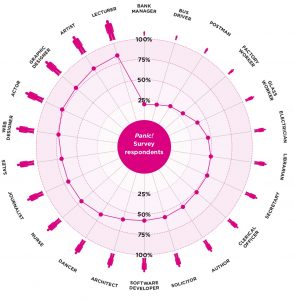1. PANIC! DON’T PANIC! NO, DO PANIC…
The message of the genuine propaganda poster shown above (attributed to Jennie Lee, Chris Smith, Czelaw Milosz or Gilberto Gil depending on what you read, but definitely not Ed Vaisey, apparently) prefigures just one of the themes in an important paper by Drs Orian Brook, David O’Brien and Mark Taylor, Panic! Social Class, Taste and Inequalities in the Creative Industries. The graphic below illustrates one way of considering the narrowness of the creative industries, demonstrating something of both family backgrounds and the circles people move in
There’s a lot in the paper, but the main worrying point is that those who reach the top are most likely to think they’ve done it on talent and hard work, and to fail to see class, ethnicity or gender as excluding others, which reinforces the inequalities in the workforce. On the one hand, most of us know this, but on the other the paper is a big step forward in providing the data to counter the meritocracy narrative and bringing together a variety of factors – workforce, creative values, background and more. It might therefore helpfully move us on from individual stories of background, which while important, are limited in understanding this situation. (Paradoxically perhaps the stories of warehousing working dads and care working mums miss the point about the system.)
2. Between what is said and what is done
Theatre maker Scottee has long articulated experiences of exclusion based on, amongst other things, class in the arts, and his recent blog on the difficulties of touring, ‘When Are You Coming To My Town’ connects to the pattern in Panic! It also illustrates the pressures on the touring system at the moment, which are also felt in other areas. Unrealistic expectations, unbalanced power dynamics, all with the seeming best of intentions and commitment to the work… but the net result is, it seems, a lot of fragility, precarity and unmet potential – including, as Scottee points out, for audiences.
3. Five Steps to a Fairer Deal
People are working to make changes to this system, of course. Gavin Barlow of The Albany, a veritable hotbed of activity, responded to Scottee’s blog by describing 5 steps the Albany are making to make things fairer. For me,the most interesting and powerful one is ‘Do less, pay more.’ Unfortunately this may also be the most challenging, at least without a connected push on arguments for funding (to the public purse, individuals or audiences) but the time has long come for this discussion.
4. Unleashing Large-Scale Change
This paper by Joe McCannon, Becky Margiotta, and Abigail Zier Alyesh sets out 8 snappy rules for making big change – such as might be needed to generate a more equitable creative sector. Not everyone will respond well to the ‘catchy’ headings for each – ‘hug the bear’, ‘name the hill’… even ‘play jazz’ will divide the crowd I guess. But there are some powerful messages here, in particular, for me, the connection between deep on the ground experience, clarity of purpose and the fact there are ‘many ways there’.
5. What you’d really like to say to funders…
Vu Le’s Nonprofit AF blog is always good for entertaining insight, most of which translates transatlantically, and this blog lands a few well-aimed punches about what grant applications would really say if people were brutally honest. (It does also beg a blog about what funders might say if they were brutally honest, but that’s another subject…)
I especially enjoyed:
‘What is innovative about your program design? “Our program is entirely innovative. The design is unproven; the approach is untested; the outcomes are unknown. We also have a tried-and-true service delivery model with outstanding results and a solid evidence base to support it. But you funded that last year and your priority is to fund innovative projects. So we made this one up. Please send money.”
and
‘How will you sustain this program after this grant runs out? We will leave you alone and harass other people, continuing to spend half our time trying to convince other foundations that our programs and communities are worth being supported, instead of running and improving the programs that our communities desperately need. Then, after a year or so, when hopefully you forgot that we applied earlier, we’ll reapply to your foundation. Please send money.’
Disclaimer: Thinking Practice accepts no responsibility if you put answers like this into Grantium, but do please let us know how you get on if you do.


Comments
Post a Comment